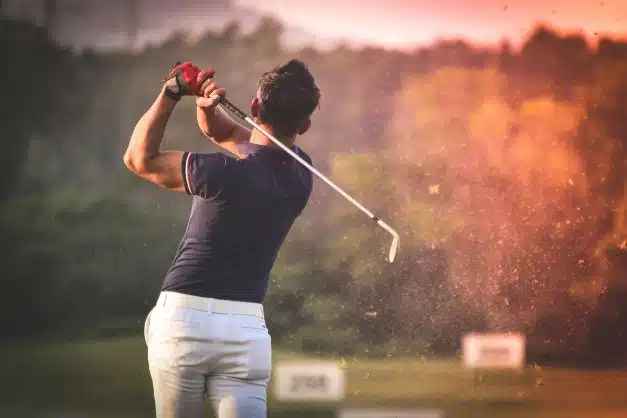Hit the links without hurting—why does golf cause back pain?
The familiar motions of a golf swing in the spring sunshine can be a powerful mood lifter—there’s a reason golf is so popular here in the Twin Cities. But with that positivity can come an unwelcome side effect—unexpected back pain.
Why does golf cause back pain? In this blog post, we’ll take a look at what contributes to pain and the top golf-related injuries. In future posts, we’ll also examine ways to prevent and treat issues.
What’s happening in my back when I swing?
Whether you’re a novice or semi-pro, golf can be risky if you’re not careful. If you’re a frequent fixture on the course, the repetitive movement of swinging a club, stooping to assess a putt, or hoisting a bag to your shoulder can cause repetition injury; if you’re brand new to the sport, poor form may cause damage. Neglecting to rotate your pelvis during a swing, for example, puts too much torque and torsion on your spine, often causing strains, and tears, among other injuries to your lumbar, neck, shoulders and hips. Over time, you may develop a facet joint disorder—that is, an injury to small spinal structures that both allow for and limit rotation, flexion and movement. With extended use, these joints can become inflamed or otherwise injured, causing back pain.
There are three major swing faults that can contribute to back pain. We’ll describe each, but if you’re a novice player, it’s helpful to bring them up with a trainer to ensure you’re swinging safely.
- Reverse Spine Angle
This describes a posture where you’ve raised the backswing so far that your torso is pointed away from your target. In this position, you can’t properly initiate the downswing with the lower body rotation, which forces the upper body to dominate the movement. This leads to excessive tension in the lower back, and more compression in the spine at point of impact. It’s one of the main reasons for lower back pain in golfers. - S-Posture
This posture is defined by too much arch in the lower back, causing the tailbone to stick out and preventing the core muscles from properly supporting the swing. This can lead to loss of posture and an out-of-sequence downswing. S-posture can be caused by postural dysfunction including tight hip flexors, tight lower back muscles, or weakness in the gluteal or general core muscles. - Hanging Back
Hanging back refers to a misfire in the downswing process—a failure to shift your weight as you move through the swing. As the club hits the ball, the weight is still primarily on the back leg, and may remain there entirely through the follow-through. This can lead to excessive trunk flexion and dominant-hand bending. Ultimately the result is torquing, compression, and pain!
These major swing faults, among many other postural variations, are the reason it’s so important to focus on proper form as a golfer.
But really, how much damage can poor form do?
A lot, actually! In addition to the back issues we’ve described, and the spinal stenosis from last month’s blog, there are four other top injuries golfers commonly complain about. They are:
- Carpal Tunnel Syndrome
Carpal tunnel doesn’t just affect office workers. Golfers are also susceptible to this painful, often debilitating disorder that causes tingling and numbness in one’s hands. - Tendonitis
Tendonitis refers to the irritation or inflammation of tendon tissues. It is typically caused by repetitive movements such as hitting golf balls or stooping to grab your tee. While you can get tendonitis in many parts of your body, golfers most often injure the inner elbow, thus earning the name “golfer’s elbow.” - Rotator Cuff Injury
In addition to elbow, hand and back pain, golfers may experience discomfort in their shoulders at various stages of the golf swing. In some cases this sensation can be the result of a damaged rotator cuff injury. Such injuries can be sustained through traumatic force, such as a poorly executed swing or a deep divot. - Hip Injuries
Lastly, many golfers experience hip pain because of repeated adduction, flexion and extension. Hip pain is sometimes a symptom of something going on in the back. In more severe cases, hip injuries can also radiate upwards and cause back pain.
Swing healthy and stay safe!
iSpine’s back pain specialists explain that golfers should always practice proper form. Having a solid swing motion will protect your spine, shoulders, and hips from overexertion and prevent serious injury. If you’re not sure what proper form looks like, consider asking an instructor or experienced friend for guidance. For even more tips on how to prevent shoulder, back and hip pain while on the green this year, set up a Pain Care Consultation, where their team of experts will learn more about your lifestyle, health history, and any major medical moments that might cause issues down the line and recommend a plan of action.


